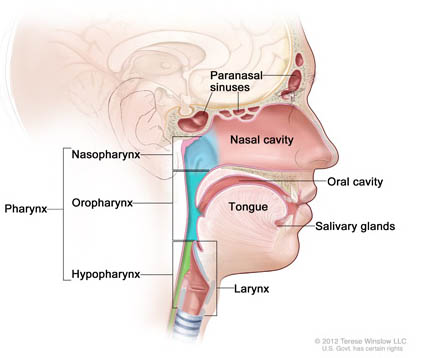Head and Neck Cancer
Head and Neck Cancer (HNC) comprises a diverse group of tumour types arising from the upper aerodigestive tract, including the lip, nasal and oral cavities, sinuses, pharynx, larynx, and other sites in this anatomical region. The vast majority of HNC diagnoses (>90%) are of squamous epithelial cell origin (oral cavity, pharynx, larynx), and are thus termed head and neck squamous cell carcinomas (HNSCC). Nasopharyngeal carcinoma (NPC) is a less common distinct HNC in that >90% of cases harbor latent Epstein-Barr virus.
HNC is strongly associated with certain environmental and lifestyle risk factors, including smoking or chewing tobacco, alcohol consumption, UV light and occupational exposures (e.g. wood dust, paint fumes, asbestos), and certain strains of viruses, such as the sexually-transmitted human papillomavirus (e.g. HPV-16).
HNC constitutes the 5th most common cancer worldwide, with 650,000 new cases per year; in Canada, there were 4550 new cases, and 1660 deaths last year (www.cancer.ca). Unfortunately >50% of such patients present with locally advanced disease, associated with dismal 5-year overall survival rates ranging from 40-60%, which has not improved significantly over the past decades. There is thus an urgent need to better understand the determinants of progression, in order to ultimately improve outcome for this group of patients.
The challenges in HNC relate to both its multiple anatomical sub-sites, and associated unique biological features; hence HNC is a complex of multitudes of malignancies. The different sub-sites, such as oral cavity, pharynxes (nasopharynx, oropharynx, and hypopharynx), and larynx, all have differing biology, histology, risk factors, and clinical management approaches. While treatment of HNC is complex due to the anatomical and molecular heterogeneity, some general principles apply, wherein surgery, radiotherapy, chemotherapy, and combinations of these are well accepted. A major challenge in treating HNC, however, is obtaining a high cure rate while preserving vital structures and function; tumors often reside in close proximity to critical organs (e.g. brain, spinal cord, optic nerve), which when damaged lead to long-term compromises in patients’ quality of life. Despite the advances in therapeutic options over the recent few decades, treatment toxicities and overall clinical outcomes have remained disappointing; for all sites and stages in the head and neck region, 5-year overall survival rates still average ~50%. These modest results underscore the urgent need to develop novel therapeutic approaches in the treatment of HNC.

Head and neck cancer regions.
Representative Publications:
|